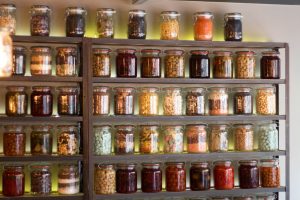There is no doubt that our current American culture lacks a true food culture, as so aptly pointed out by Eddie. We are a country of immigrants. We do come from many backgrounds. We are a melting pot.
But I don’t think those are the reasons we lack a food culture. My theory is a bit different.
I believe we are a nation swallowed up by industrialism. That self-titled revolution created a lot of change in this country, and food was no exception.
You see, we live in a large nation – a nation which you could drive across for years and always be coming across a unique climate and geography. Our country is made up of regions and those regions each have their own microclimate.
And every microclimate produces its own type of food.
Before I lose you here, pay close attention to this: Before food was shipped via railway how do you think people ate?
They ate almost entirely locally because they had to, because it was how life was lived, and because it was (and still is) the only thing that really makes sense in terms of nourishing families while stewarding our land.
This period of time, before the railway, was also long before our nation of farmers became a nation of urban and suburban-dwellers.
- In 1760 farmers made up 90% of the workforce.
- In 1840 farmers made up 69% of the workforce.
- In 1900 farmers made up 38% of the workforce.
- In 1950 farmers made up 12.2% of the workforce.
- In 1990 farmers made up 2.6% of the population.
So now a group of 60,000 grow enough food to feed three million people. Does that make sense to you?
Prior to this huge shift in the way food was produced, procured, and processed; people in different areas of our country did have a food culture and all were unique to their own region.
Their food culture was based on two things: where they came from and where they lived.
If they were immigrants from Ireland potatoes were familiar and a mainstay crop, so long as they were in an area of the country that could grow potatoes. If they were immigrants from Germany then their ancestor’s traditional recipes for things like sauerkraut were tucked away in their pocket, or even their memory.
But if you were in a dry area of the country you would have to grow crops that were drought tolerant. If you were in a wet climate, like the northeast, you might rely more heavily on water-loving crops. And in that northeast you would have plentiful seafood whereas in the arid south you might eat plenty of free-range beef.
Many homesteads grew calorie crops such as potatoes – white (or sweet in the south), beans, small-scale grains like corn or wheat. But even these foods were different from region to region, the seed acclimating to the specific microclimate of the area over the course of years of seed-saving and then seed-planting.
The industrializing of the food system and the mass exodus of subsistence farmers in this country blew those regional food cultures to the four winds. Suddenly all types of food were available from all areas, and the land-based food and life culture scattered just as the farmers did.
I do believe it is possible to reclaim those food cultures that once made each region distinct and wonderful. In the next post I will share some ideas for how to do that.








